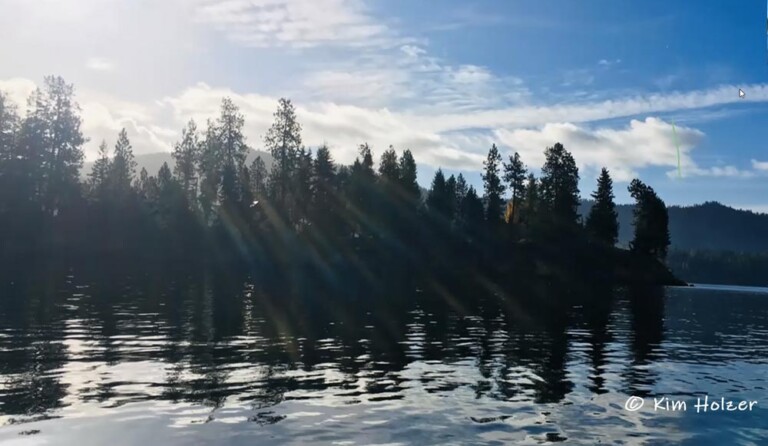Watch the video of Dr. Kim Holzer’s presentation below.
“A Lake without plants is not a healthy Lake.”
The aquatic plant community in Hayden Lake includes a mixture of native, nonnative, and invasive plants.
- A native plant is indigenous and belongs in the lake system.
- A nonnative plant has been introduced but may not cause demonstratable harm.
- An invasive plant also referred to as a noxious weed, is introduced and causes harm to the environment, the economy, and human health.
“We have a whole lot of great native plants and not that many invaders; you just need to be able to distinguish between these.”
Native Plant
Some may also call Spatterdock a lilypad. Its leaves are larger, and the flowers are only yellow.
Image © Kim Holzer
Native Plant
The native Elodia or waterweed is often mistaken for milfoil.
Image © J. Roman
Native Plant
The Coontail has 4 leaves around a whorl. Look closely. The leaves look like mule-deer antlers.
Image © Kim Holzer
Native Plant
Water Buttercup or Crowfoot has large segments between the leaf arrangements. It is often confused with milfoil.
Image © Kim Holzer
Non-native Plant Not Invasive
A lot of people call this a Lily pad. It has heart-shaped leaves and white or pink flowers.
Image © Kim Holzer
Native Plant
The native big-leaf pondweed is often mistaken for curly-leaf pondweed.
Image © J. Roman
Invasive Plant
Eurasian Watermilfoil and its hybrids have a red stem and feather-like leaves in whorls around the stem. Each leaf has 12 or more leaflet pairs.
Image © Kim Holzer
Invasive Plant
Curly-leaf Pondweed has lasagna-like leaves that are somewhat translucent with serrated margins. Its pinecone-like turions are present late in the summer and into the fall.
Image © Kim Holzer
The Benefits of Native Plants
Many gorgeous native plants carpet Hayden’s lakebed. They provide shelter and abundant food for fish and wildlife. They support biodiversity in the local environment. Many improve water quality by pumping oxygen into the water column and clarity by stabilizing the sediment. They act as a nutrient sponge, impeding different types of algal blooms. And, a healthy native plant community can prevent an invader from taking hold! In total, native plants are good for Hayden Lake.
The Downside of Invasive Plants
Invasive plants can overwhelm native plants and monopolize an area. When this happens, the high plant density and lack of biodiversity rob local fish and wildlife of habitat. It slows the water flow and thereby reduces oxygenation of the water column. Invasive species interact with the native plants and produce hybridized super-plants that are even more robust than their ancestors. They clog water intakes and make popular recreational areas inaccessible. Ultimately, invasive plants are bad for Hayden Lake.
“Think about ways that you can cultivate healthy natives
and not foster the invaders.”
Note that invasive plants take advantage of natural and artificial disturbances. One such disturbance is the removal or loss of native plants that opens up the lakebed. When that happens, the invaders take off and flourish.
Certain human activities facilitate nutrient-enriched runoff and therefore the growth of the invaders. Clearing the shoreline of natural vegetation, fertilizing our lakeside lawns, and blowing leaf debris into the lake are examples of activities that feed invasive plant and algae growth. Enhanced nutrient runoff can also be driven by weather events like snow-melt, just bringing natural nutrients from the watershed.
“You can still manage the natives, but just know that if you remove them completely from the lakebed, you’re opening up real estate for some aggressive invaders.”
- Mechanical – physically removing the plants via harvesters, rakes, or by hand.
- Biological control – use the plants’ natural enemies that specialize in the invader. Science hasn’t demonstrated that biological controls of the two problem species that invade our lake are effective.
- Chemical herbicides – formulated chemical compounds that target one species or plants in general. An IDPDES permit is required to apply herbicides in the lake.
- Cultural practices include managing the lake level and installing benthic barriers.



